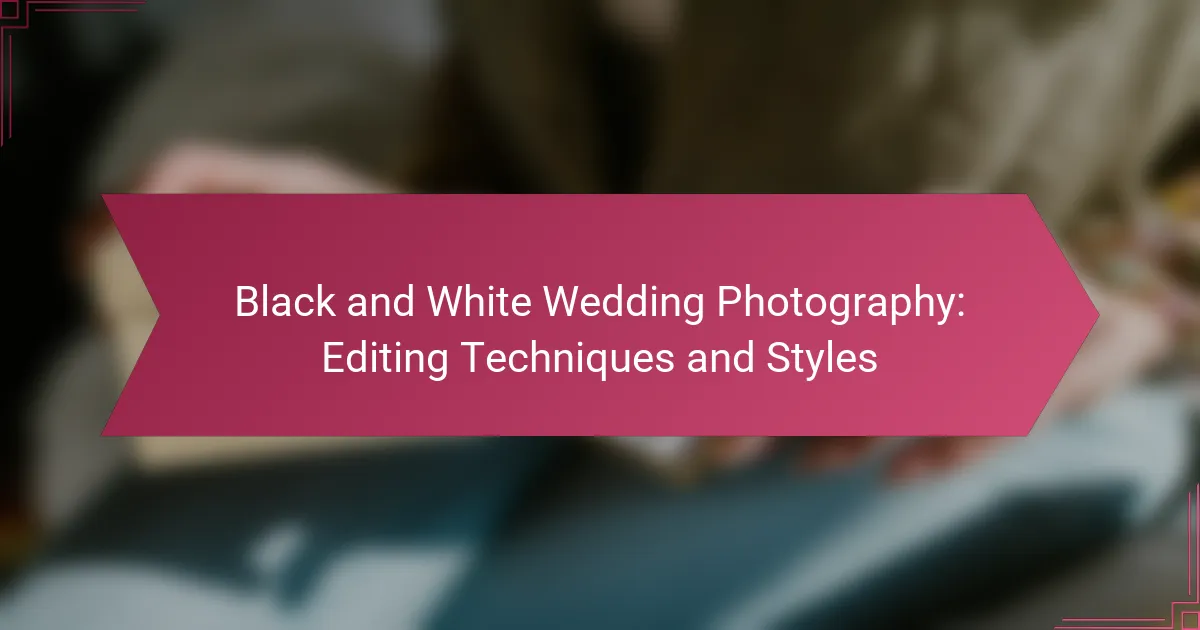Black and white wedding photography offers a timeless appeal, with editing techniques that enhance contrast, mood, and texture to create striking visuals. Various styles, such as Classic Noir and Fine Art, allow photographers to emphasize different aspects of the wedding day, from emotion to storytelling. Choosing the right editing software is essential for achieving the desired aesthetic and streamlining your workflow.
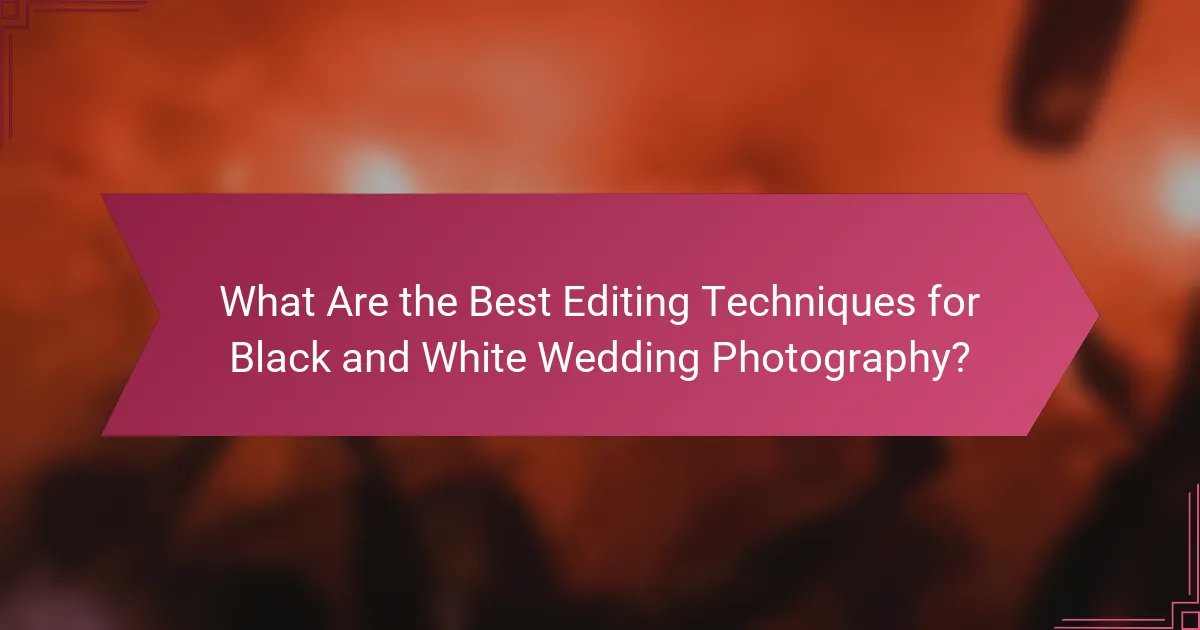
What Are the Best Editing Techniques for Black and White Wedding Photography?
The best editing techniques for black and white wedding photography focus on enhancing contrast, mood, and texture. These methods can transform images into striking visuals that capture the essence of the day while emphasizing emotions and details.
High Contrast Editing
High contrast editing involves adjusting the tonal range to create bold differences between light and dark areas. This technique can make images more dramatic and visually striking, which is ideal for capturing the emotional highs of a wedding.
To achieve high contrast, increase the blacks and whites while reducing midtones. Use tools like curves or levels in editing software to fine-tune the contrast. Be cautious not to lose detail in the shadows or highlights, as this can detract from the overall quality.
Soft Focus Techniques
Soft focus techniques create a dreamy, romantic effect by slightly blurring the image. This style is particularly effective for portraits and intimate moments, adding a layer of emotion and nostalgia.
To apply soft focus, use a lens filter or post-processing tools to reduce sharpness. Aim for a subtle blur that enhances the image without compromising clarity. This technique works best in well-lit conditions to maintain a pleasing aesthetic.
Split Toning Adjustments
Split toning adjustments involve adding different colors to the highlights and shadows of an image, even in black and white photography. This technique can enhance mood and create a unique atmosphere in wedding photos.
When applying split toning, choose warm tones for highlights and cooler tones for shadows to evoke a sense of warmth and intimacy. Adjust the balance carefully to ensure the effect complements the overall composition without overwhelming it.
Dodging and Burning
Dodging and burning is a classic technique used to selectively lighten (dodge) or darken (burn) specific areas of an image. This method helps to draw attention to key elements and adds depth to the photograph.
Use a soft brush tool in your editing software to apply dodging and burning. Focus on enhancing facial features, wedding attire, or other focal points while maintaining a natural look. Avoid overdoing it, as excessive manipulation can lead to an unnatural appearance.
Grain Addition
Grain addition can enhance the texture and character of black and white wedding photographs, giving them a timeless quality. This technique mimics the look of classic film photography, which many couples find appealing.
To add grain, use the noise or grain filter in your editing software. Adjust the intensity to achieve a subtle effect that enhances the image without becoming distracting. A light grain can evoke nostalgia, while too much can detract from the overall quality.
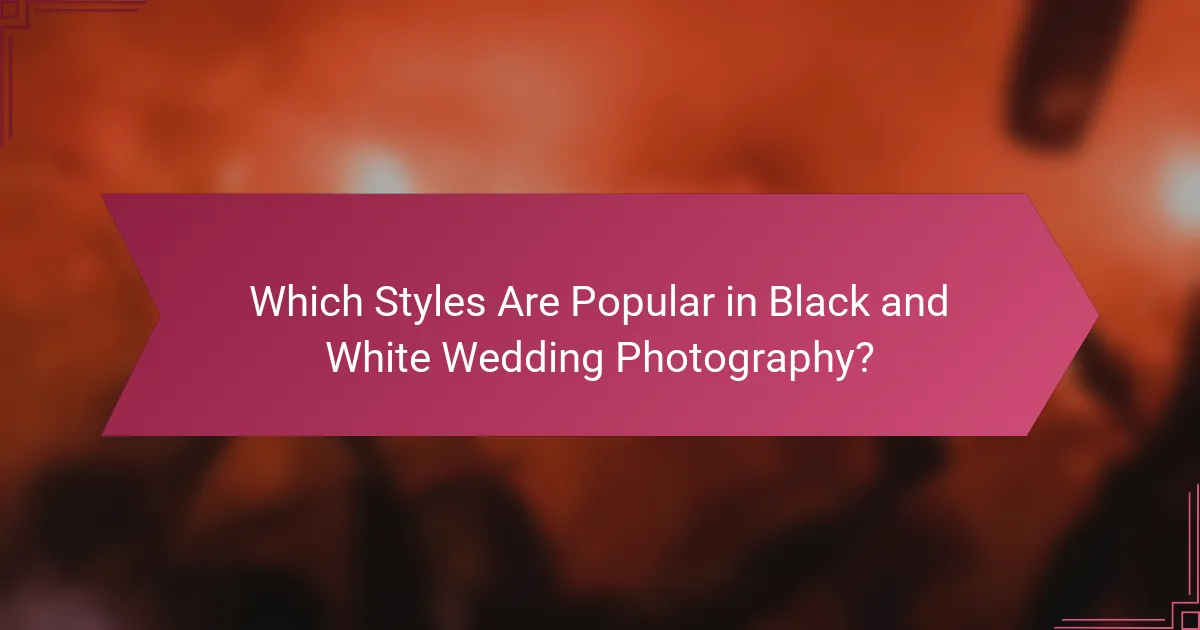
Which Styles Are Popular in Black and White Wedding Photography?
Popular styles in black and white wedding photography include Classic Noir, Documentary, Fine Art, and Minimalist. Each style offers a unique approach to capturing the essence of the wedding day, emphasizing different elements such as emotion, storytelling, and artistic expression.
Classic Noir Style
The Classic Noir style is characterized by its dramatic contrasts and deep shadows, reminiscent of vintage film noir. This style often uses strong lighting techniques to create a moody atmosphere, focusing on the couple’s emotions and interactions.
When shooting in this style, consider using natural light during golden hour or employing artificial lighting to enhance shadows. The goal is to evoke a timeless feel, so aim for compositions that highlight the couple’s connection and the day’s emotional weight.
Documentary Style
Documentary style photography captures candid moments as they unfold, telling a story without interference. This approach emphasizes authenticity, allowing the couple and guests to express genuine emotions throughout the event.
To achieve this style, photographers should remain unobtrusive, blending into the background while being ready to capture spontaneous interactions. Focus on key moments such as laughter, tears, and celebrations, ensuring that the final collection reflects the true essence of the day.
Fine Art Style
Fine Art style photography combines artistic vision with wedding documentation, often resembling a gallery of art pieces. This style emphasizes composition, lighting, and aesthetics, creating visually stunning images that stand out.
Photographers should plan for creative angles and unique perspectives, incorporating elements like architecture and nature into the shots. Use post-processing techniques to enhance textures and contrasts, ensuring that each image feels like a work of art.
Minimalist Style
The Minimalist style focuses on simplicity and clean lines, stripping away distractions to highlight the couple and their emotions. This approach often features a limited color palette and uncluttered backgrounds, allowing the subjects to take center stage.
To achieve a minimalist look, choose locations with simple backgrounds and use negative space effectively. Pay attention to details such as framing and composition, ensuring that each shot conveys a sense of elegance and clarity.
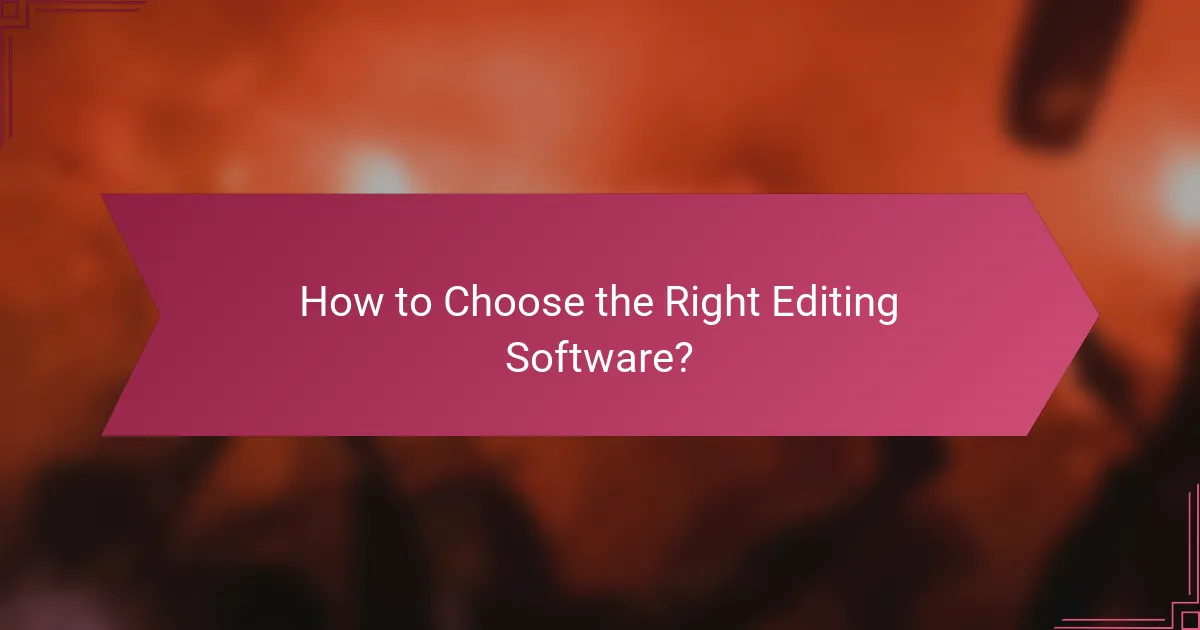
How to Choose the Right Editing Software?
Selecting the right editing software for black and white wedding photography is crucial for achieving the desired aesthetic and efficiency. Consider factors such as user interface, available features, and compatibility with your workflow to find the best fit for your needs.
Adobe Lightroom
Adobe Lightroom is a popular choice among photographers for its user-friendly interface and powerful editing capabilities. It excels in batch processing, allowing you to edit multiple images simultaneously, which is ideal for wedding photography where you may have hundreds of shots to process.
Lightroom offers a range of presets and tools specifically designed for black and white photography, enabling you to easily adjust contrast, exposure, and tonal range. The software also integrates well with Adobe Photoshop for more advanced edits when necessary.
Adobe Photoshop
Adobe Photoshop is renowned for its extensive editing capabilities, making it a go-to for photographers seeking detailed control over their images. While it has a steeper learning curve than Lightroom, it offers advanced features like layer manipulation and selective adjustments that can enhance black and white images significantly.
For wedding photography, Photoshop allows for precise retouching and the application of creative effects, such as adding grain or texture to your black and white images. However, it’s best used in conjunction with Lightroom for initial edits and organization.
Capture One
Capture One is favored by many professional photographers for its exceptional color grading and tethering capabilities. Although it is primarily known for color photography, its tools for black and white conversion are robust, providing detailed control over tonal adjustments.
This software is particularly useful for photographers who shoot in RAW format, as it offers superior image quality and flexibility in post-processing. Capture One’s customizable interface can be tailored to your workflow, making it a powerful option for wedding photography.
Affinity Photo
Affinity Photo is a cost-effective alternative to Adobe products, offering a wide range of features suitable for black and white photography. It includes advanced editing tools similar to Photoshop, allowing for detailed adjustments and creative effects.
While it may not have the same level of integration with other software, Affinity Photo is a solid choice for photographers on a budget who still want professional-quality editing capabilities. It supports various file formats, making it versatile for different workflows.
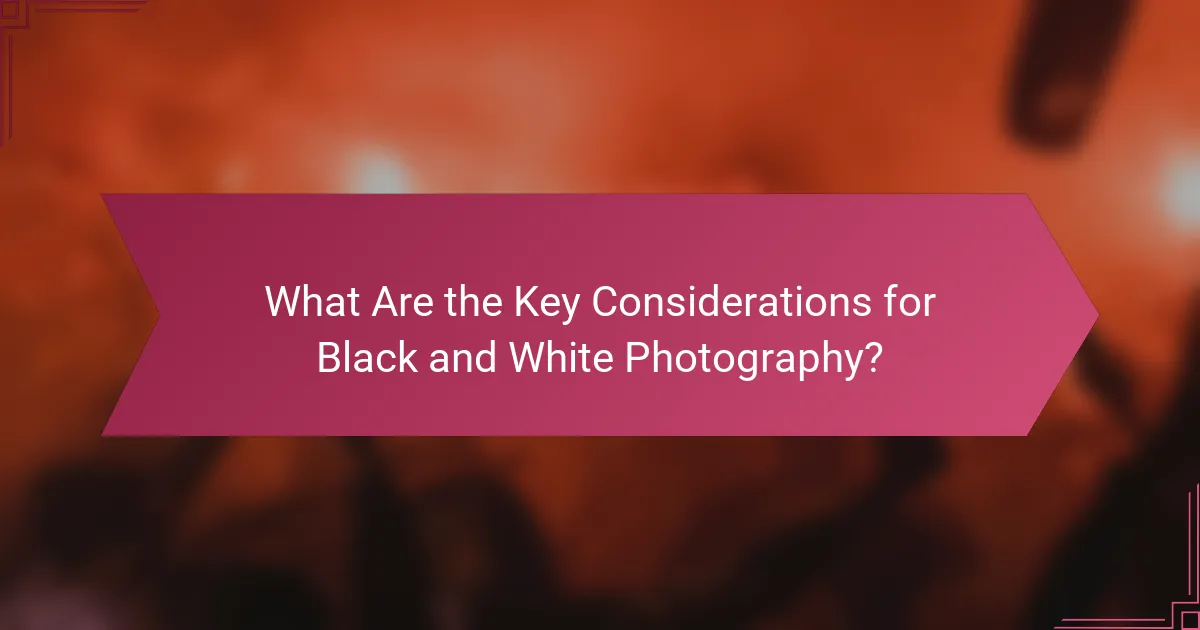
What Are the Key Considerations for Black and White Photography?
Key considerations for black and white photography include understanding lighting, selecting appropriate subject matter, and applying effective composition techniques. Each of these elements plays a crucial role in creating impactful monochrome images that convey emotion and depth.
Lighting Conditions
Lighting is fundamental in black and white photography, as it defines contrast and texture. Natural light, especially during golden hours, can enhance shadows and highlights, creating a dramatic effect. Artificial lighting can also be manipulated to achieve desired contrasts, but it requires careful control to avoid flat images.
Consider using diffused light for softer shadows or direct light for strong contrasts. Experimenting with different lighting setups can help you understand how light interacts with your subjects in monochrome.
Subject Matter
Choosing the right subject matter is essential for effective black and white photography. Subjects with strong shapes, textures, and patterns often translate well into monochrome. Portraits, landscapes, and architectural shots can all benefit from the absence of color, allowing viewers to focus on form and emotion.
Avoid overly busy scenes that may distract from the main subject. Instead, look for simplicity and clarity in your compositions, which can create a more powerful visual impact.
Composition Techniques
Composition techniques in black and white photography should emphasize balance, leading lines, and framing. Use the rule of thirds to position your subjects effectively, and consider how negative space can enhance the overall composition. Strong lines and shapes can guide the viewer’s eye through the image.
Incorporate textures and patterns to add depth and interest. Experiment with angles and perspectives to find unique compositions that highlight the strengths of black and white imagery. Always review your images in monochrome during editing to ensure they maintain visual appeal without color.
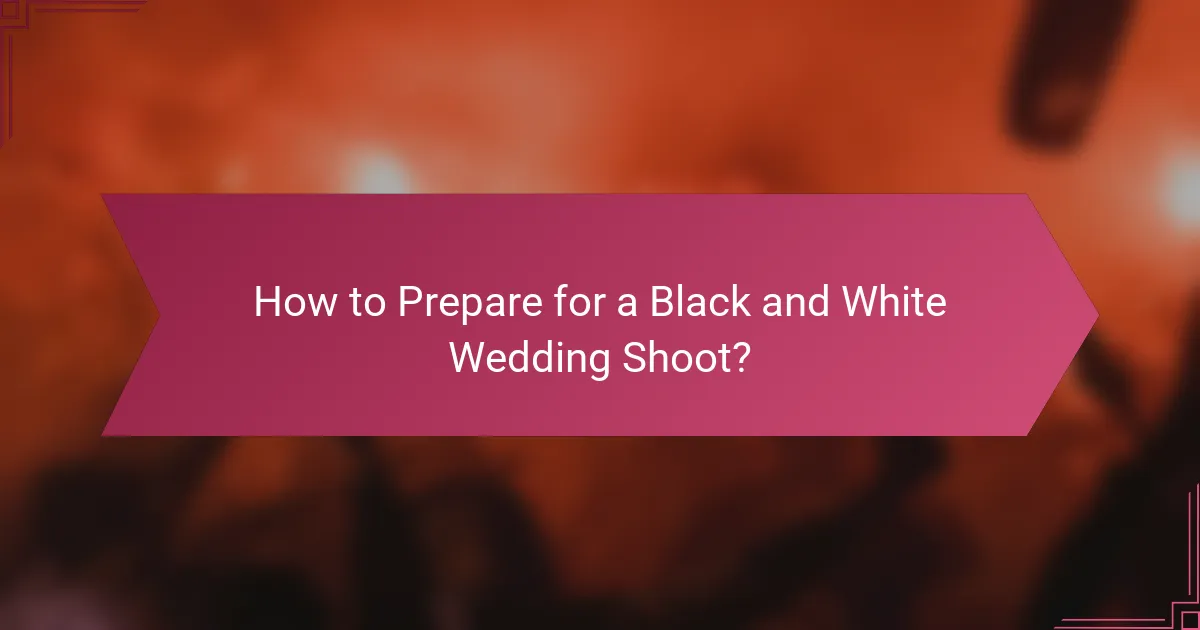
How to Prepare for a Black and White Wedding Shoot?
Preparing for a black and white wedding shoot involves careful planning and consideration of various elements that influence the final images. Key aspects include understanding the couple’s vision, selecting appropriate locations, and ensuring the right equipment is on hand for optimal results.
Pre-Shoot Consultation
A pre-shoot consultation is essential for aligning the photographer’s style with the couple’s expectations. Discuss their preferences for black and white photography, including any specific moments or emotions they want to capture.
During this meeting, review previous work to establish a visual reference. This helps ensure that both parties are on the same page regarding the desired aesthetic and mood of the images.
Location Scouting
Location scouting plays a crucial role in preparing for a black and white wedding shoot. Identify sites that offer strong contrasts, interesting textures, and varied lighting conditions, as these elements enhance the depth and drama of monochrome photography.
Consider visiting locations at different times of day to assess how natural light affects the scene. This can help in planning for optimal shooting times and angles, ensuring the best possible results on the wedding day.
